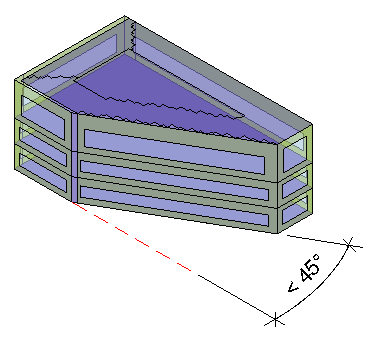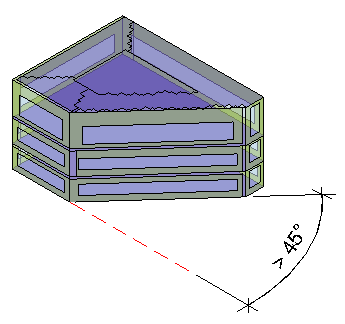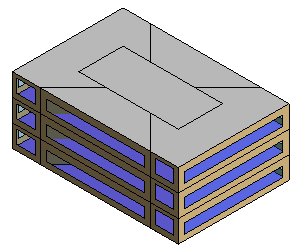When preparing the model for energy analysis, use automatic thermal zoning to improve the accuracy of energy simulations.
Typical thermal zoning consists of groups of perimeter zones with exterior exposure, and groups of core zones with little or no exterior exposure. The core of a building is generally not exposed to the variation of heat gains and losses experienced by perimeter zones. Therefore, the core's heating and cooling loads differ from those for the perimeter of the building. Thermal zoning accounts for these differences in energy simulations.
The software offers automatic thermal zoning to improve the accuracy of energy simulations without additional modeling. When creating the energy model, the software divides the building into zones specific to the geometry at each floor based on ASHRAE modeling recommendations.
Automatic thermal zoning is important when you have not yet made design decisions about the building's internal layout and are not sure how the building will be zoned for HVAC systems. As a result, you can perform early-stage energy simulations and make critical design decisions early in the process. When you update the energy analytical model to reflect changes to the design, the automatic thermal zones are updated as well.
The type of automatic thermal zoning performed by the software depends on the Mode parameter specified in the Energy Settings dialog:
| For... | Set Mode to... |
|---|---|
| Advanced automatic thermal zoning that provides more accurate results without additional modeling (recommended)
(for use with masses or building elements or both) |
Use Conceptual Masses and Building Elements |
| Simplified automatic thermal zoning that improves results without additional modeling
(for use with masses only) |
Use Conceptual Masses |
| No thermal zoning; instead, energy simulations rely on rooms and spaces placed in the model or rooms defined by room-bounding building elements
See About Thermal Properties for Energy Analysis. (for use with building elements only) |
Use Building Elements |
As an alternative to automatic thermal zoning, you can perform custom thermal zoning to more accurately reflect your design intent. For example, you may want to model an atrium that spans multiple levels and so should be represented by its own thermal zone.
Advanced thermal zoning
Advanced thermal zoning uses sophisticated algorithms to improve the accuracy of energy simulations. It does not add elements to the energy model. Instead, it uses analytical spaces and analytical surfaces to describe thermal zones.
You can use this type of automatic thermal zoning for models that consist of conceptual masses, building elements, or both. Advanced thermal zoning is the recommended method for energy simulations.
For advanced thermal zoning, define the following parameters in the Energy Settings dialog:
- Mode: Use Conceptual Masses and Building Elements
- Perimeter Zone Depth: the distance to measure inward from the exterior walls to define the perimeter zone
- Perimeter Zone Division: enabled
When you create an energy model using these settings, the software divides space into thermal zones when a turn in the building perimeter exceeds 45 degrees.


Simple thermal zoning for conceptual masses
For conceptual masses, simple thermal zoning automatically divides the building into the core and 4 thermal zones for the perimeter: northeast, southeast, northwest, and southwest.

For simple thermal zoning, create a model that uses conceptual masses, and define the following parameters in the Energy Settings dialog:
- Mode: Use Conceptual Masses
- Perimeter Zone Depth: the distance to measure inward from the exterior walls to define the perimeter zone
- Perimeter Zone Division: enabled